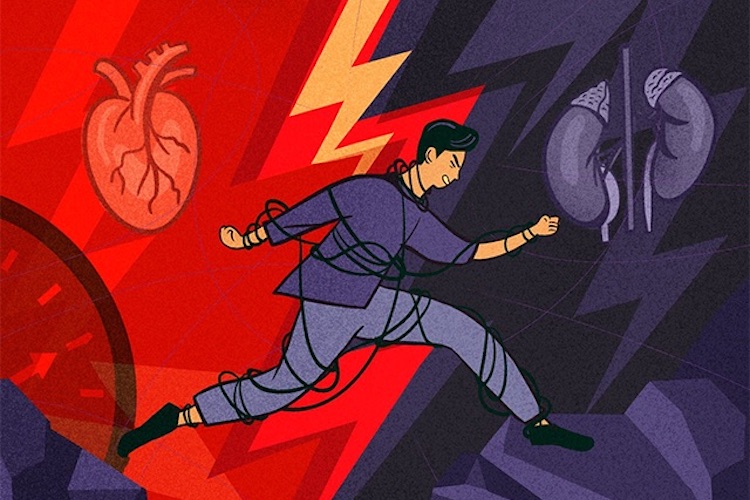The Anthropocene Biosphere
Scientists have assessed the contribution of humans as a species to the history of life on Earth

Adrenaline is one of the most known hormones in the human body, with a very powerful effect on the organs of the body. Evolutionary developed as a response to extreme situations, adrenaline helps to exercise the organism to the maximum of its capacities.
The history of the discovery of adrenaline was rocky, and most of it was a result of incorrect experiments, but fortuitously it led to great discoveries. In contrast to the majority of endocrine glands, some of which were already discovered by Galen in the 2nd century, the adrenal glands have been overlooked for centuries and were only discovered in the 16th century. Even then, the function of the adrenal glands was entirely unknown until the middle of the 19th century, when some clues emerged. For example, in 1716, the Académie des sciences de Bordeaux in France had a competition asking: Quel est l’usage des glandes surrénales? (What is the use of the adrenal glands?). The later famous Charles de Montesquieu (1689-1755) judged the competition. After reading the prize submissions, Montesquieu decided that none of the submissions merited a prize and expressed the hope that one day the problem of the adrenals would be solved.
The first hint that the adrenal glands were important came from the clinical observations of the British physician Thomas Addison in 1855. He had consulted on patients who were severely fatigued, had weight loss, vomiting, and a strange darkening of the skin. He found at the autopsy of the patients that they all had damaged adrenal glands. He proposed that the destruction of the adrenal glands — organs with no known function — caused their deaths. About a year later, Charles-Édouard Brown-Séquard in France surgically removed the adrenal glands from laboratory animals. All the animals died, supporting the hypothesis that the adrenals were essential for life.

Neither Addison nor Brown-Séquard knew the actual function of the adrenal glands. Developing evidence that glands like the adrenals secrete active chemicals into the blood was a major intellectual hurdle. Also, it was hard to demonstrate with available methods in the latter half of the 19th century. In 1889, Brown-Séquard, being already 72 years old and a very famous senior scientist, announced that he had been rejuvenated by injections of extracts of animal sperm and testicles. This was an incorrect experiment as there was not enough male hormone testosterone used to do anything. But Brown-Séquard’s claims created a worldwide sensation. He stimulated interest in the possibility that extracts of organs might have major physiological effects.
In London, Oliver met a famous physiologist Professor Edward Sharpey-Schafer, who, as a matter of pure interest, injected an extract of the adrenal glands into dogs and was astonished to find that the blood pressure in dogs rose tremendously. This was the first and clear example that the substance produced in the inner gland had tremendous physiological effects. Immediately after that, a race was on to find what was the substance in the adrenal gland that caused the blood pressure to rise. There were labs throughout the world, particularly in Germany, England, and the US, that tried to purify that substance. A number of people claimed to have found it, but the actual discovery happened in 1901. The active substance in the adrenal glands that is responsible for raising blood pressure was isolated by Jokichi Takamine, a Japanese immigrant in the United States. He named it ‘adrenaline’.

Adrenaline represents a small molecule synthesized in the center of the adrenal gland — the medulla. The body takes an amino acid called tyrosine as a starting point to add specific chemical groups to make adrenaline. After being synthesized, adrenaline is stored in the gland until there is a need for it. At that moment, the hormone is secreted into the blood to act on distant organs. The idea of what it does was first formulated by Walter Cannon, a famous physiologist at Harvard medical school, in 1910-1940. By then, it was known that Adrenaline affects almost every organ in the body, but Walter Cannon summed it all together, introducing the notion of a “fight or flight response”.

Our ancient ancestors living in a hostile world had to be prepared to react to threats and to be able to mobilize all resources in a short period of time. A rabbit, when approached by a wolf, has to run away, so a wolf, in order to catch a rabbit, has to run at a maximal speed. The adrenaline that the adrenal glands of the rabbit and wolf will release will integrate all the organs in the body to respond to the need for maximal exertion. The “Fight of flight response” refers to the primary instinct of the predatory or victim to exercise, which the help of adrenaline will be needed. The hormone will increase the output of blood from the heart to the exercising muscles — bringing more oxygen and nutrients to keep muscles going vigorously. It will cause a heart to beat faster and harder, push the liver to release glucose into the blood and make fat to release fatty acids and glycerol, which are nutrients for muscles. In the end, adrenaline will cause the airways in the lungs to dilate, allowing faster and easier breathing.
Adrenaline glands are located near the kidneys, and they were missed for thousands of years because they are usually covered up in fat. There are two names for this hormone, which are synonyms: adrenaline and epinephrine. The world health organization’s name is epinephrine, and it comes from the Greek “Epi” (near) and “Nephron” (kidney). Adrenaline is Latin – “ad” (side) and “renal” (kidney).
Does Adrenaline have anything to do with the feeling of excitement? Many people think that. In English, there are common expressions with adrenaline, for example: “getting someone’s adrenaline going” or “adrenaline junkie”. However, adrenaline has no direct connection with how we feel. Getting on a roller-coaster ride in an amusement park, you might feel excited or frightened. That will trigger adrenaline secretion, but a “feeling” largely comes from the brain. Adrenaline cannot go from the blood into the brain. There are blood-brain barriers that keep it out. Likewise, when adrenaline is injected into people into laboratories, they will feel their heart rate rising, and they may feel a little strange, but they will not experience fear or excitement.
It is possible that stimulation from the body affects the emotional experiences we have, as there are many receptors in tissues carrying nerve signals back to the brain. However, it is important to notice that an experience stimulates the secretion of adrenaline, but not vice versa. Emotion first, then adrenaline secretion second.
Adrenaline is not only released under fear. There is some amount of it released constantly. The level of secretion goes up in response to things that require greater activity of the body. The downside of that, in our modern world, is that things like fear or emotions that do not trigger a physical activity can also stimulate the release of adrenaline. Anything that is exciting can activate the release of adrenaline, including video games, watching a movie thriller, attending a soccer match, and getting into an argument. Typical responses are what you would expect: heart beating harder and faster, perspiration under the arms, and slight tremors of the hands if very agitated. The health consequences are generally not important. However, in some people, especially people over 50 or those with existing heart disease, stress responses to sudden excitement can precipitate a heart attack. How emotions can trigger sudden death or heart attacks is an active area of medical investigation.
People can live normal life without any adrenaline. People that had their adrenal glands surgically removed get pills to replace the cortisol and aldosterone (the two hormones produced in adrenal glands that are essential for life), but they do not need any treatment with adrenaline. Life is possible without it. However, those people would most probably not be able to exert themselves to the maximum that they could see when they still had their adrenal glands.
Shortly after the discovery of adrenaline, it was found that it could help in cardiac resuscitation. Adrenaline was used in the treatment of many problems, such as asthma, anaphylactic shock, and croup in infancy, to give a few. Dentists use adrenaline by injecting it into the gums, together with the local anesthetic, as adrenaline enables the blood vessels to let a local anesthetic stay longer in the teeth.
The use of adrenaline in the treatment of cardiac arrest — to start the heart going again — is probably the most known. In the US, cardiac arrest kills several hundred thousand people each year. Many of these deaths are due to ventricular fibrillation, often caused by a heart attack. For more than 100 years, adrenaline has been used as a drug in cardiopulmonary resuscitation in an effort to revive these people. Although not conclusive, several recent studies have suggested that adrenaline may not be desirable in cardiac arrests. Just a few years ago, an editorial in the Journal of the American Medical Association suggested that it would be useful and ethical to conduct a serious clinical trial to find out if adrenaline was either beneficial or harmful during cardiac arrests. Despite the modern emphasis on ‘evidence-based medicine’, a substantial fraction of current diagnostic and therapeutic clinical practices lack a strong foundation.
If a sportsman wants to take doping, he or she will not use adrenaline directly but will use related drugs. One of the most important is clenbuterol, which is an adrenaline-like drug. In Europe, it was heavily used in cattle feed to increase the size of muscles and lower body fat. Many Olympic athletes have been banned from competition for taking clenbuterol. This used to be a problem for those athletes who have asthma, but recently, the Olympic officials allowed certain adrenaline-like drugs to be used by asthmatic people. As adrenaline substitute is inhaled through the lungs the concentrations are still too low to affect muscles much.
Contrariwise, there are drugs that block the effect of adrenaline — beta-blocking drugs like propranolol. Those are also banned in some Olympic sports, particularly shooting. Adrenaline, when you get excited, can make your hands shake. A shooter taking a drug that blocks the effect of adrenaline can shoot straighter. There have been precedents of athletes being banned from competition for taking these drugs. However, not only athletes use them; it is quite common when professional musicians take such a drug to block the effect of adrenaline in order to hold their hands more steadily.
The most exciting question is how exactly adrenaline works. The whole signaling pathway of adrenaline is a model for many other drugs and hormones. Most drugs work by interacting with specific chemicals in the body, and adrenaline as well interacts with specific proteins called adrenaline receptors. These are executing genes family of self-surface receptors called the G-protein-coupled receptors.

Someone has estimated that 10-20 % of the available drugs work through G-protein-coupled receptors. Adrenaline (or any other drug or hormone) fits into them like a key into a lock. In 2012 Robert Lefkowitz at Duke University and Brian Kobilka at Stanford University shared a Nobel prize in chemistry for their work on the structure of these receptors. Kobilka has continued to do work using X-ray crystallography to see exactly how adrenaline sits into these proteins and how the conformation of the protein changes.
That is an enormous part of medicine. A deeper understanding of how these signaling pathways work is of fundamental biological interest and could have therapeutic implications. It could lead to new drugs with novel capacities to activate the adrenaline receptors.
Adrenaline, Brian B.Hoffman (Harvard University Press, 2013)
Edited by Irina Laevskaya

Scientists have assessed the contribution of humans as a species to the history of life on Earth

Molecular Neurogeneticist David Rubinsztein on neurodegenerative diseases, stem cells, and fluorescent protein...

Geneticist Steve Jones on skin cancer, the effect of vitamin D and why the sunlight is good for health and dan...